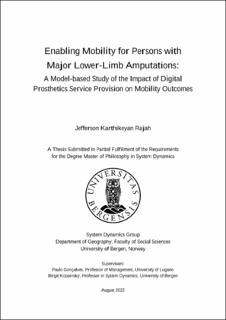| dc.contributor.author | Rajah, Jefferson Karthikeyan | |
| dc.date.accessioned | 2022-08-24T23:43:13Z | |
| dc.date.available | 2022-08-24T23:43:13Z | |
| dc.date.issued | 2022-08-19 | |
| dc.date.submitted | 2022-08-24T22:00:26Z | |
| dc.identifier.uri | https://hdl.handle.net/11250/3013376 | |
| dc.description | Revised version. Minor formatting errors corrected. | |
| dc.description.abstract | The World Health Organization has predicted a doubling in the global population for persons with amputation by 2050 because of steady population growth, ageing populations, and climbing rates chronic conditions such as peripheral arterial disease and diabetes mellitus. Without proper and timely prosthetic interventions, amputees with major lower-limb loss experience adverse mobility outcomes, including the loss of independence, lowered quality of life, and decreased life expectancy. Yet, a vast majority of amputees still do not have access to prosthetic services given the present capacity constraints, lack of proximity to services, high costs and poor healthcare coverage. Today, the entry of digital technology to the prosthetics services industry (e.g., 3D-printed sockets) is touted to be a plausible solution to this problem. This thesis aims to assess the impact of digital prosthetics on the amputee mobility outcomes – specifically, the proportion of amputees who successfully regain mobility from using a prosthesis and the health-economic consequences of such mobility. Using the system dynamics approach, this study presents a computational simulation model ¬– representing the patient-care continuum and digital prosthetics system – that provides a feedback-rich causal theory of how digital prosthetics impacts amputee mobility outcomes over time. In general, this study has found that with sufficient resources for market formation and capacity expansion for digital prosthetics services, substantial improvements to mobility outcomes for amputees can be expected. In doing so, it serves as proof-of-concept for the viability of scaling digital prosthetics for enabling mobility and bolstering the social impact of providing a prosthesis. Based on the high-leverage policy levers found in the system, this study further discusses the model-based insights that could inform policy design for alleviating the barriers to access and enhancing the health-economic outcomes of prosthetics care. | |
| dc.language.iso | eng | |
| dc.publisher | The University of Bergen | |
| dc.rights | Copyright the Author. All rights reserved | |
| dc.subject | Mobility | |
| dc.subject | System Dynamics | |
| dc.subject | Major Lower-Limb Amputation | |
| dc.subject | Prosthetics Service Provision | |
| dc.title | Enabling Mobility for Persons with Major Lower-Limb Amputations: A Model-based Study of the Impact of Digital Prosthetics Service Provision on Mobility Outcomes | |
| dc.type | Master thesis | |
| dc.date.updated | 2022-08-24T22:00:26Z | |
| dc.rights.holder | Copyright the Author. All rights reserved | |
| dc.description.degree | Master's Thesis in System Dynamics | |
| dc.description.localcode | GEO-SD351 | |
| dc.description.localcode | INTL-KMD | |
| dc.description.localcode | INTL-MED | |
| dc.description.localcode | INTL-SV | |
| dc.description.localcode | INTL-JUS | |
| dc.description.localcode | INTL-HF | |
| dc.description.localcode | INTL-PSYK | |
| dc.description.localcode | INTL-MN | |
| dc.description.localcode | MASV-SYSDY | |
| dc.subject.nus | 733199 | |
| fs.subjectcode | GEO-SD351 | |
| fs.unitcode | 15-41-0 | |
